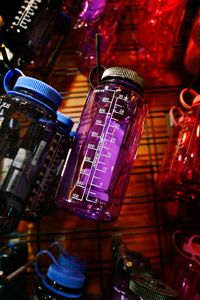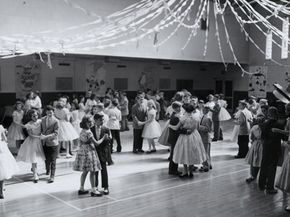 “Starting puberty earlier than normal is becoming more and more common in girls.Patrick Bernard/Photonica/Getty Images
“Starting puberty earlier than normal is becoming more and more common in girls.Patrick Bernard/Photonica/Getty Images
Puberty is the time, usually between ages 10 and 12, when girls develop into women and boys transform into men. Most of us can remember puberty by its more awkward moments — acne erupting all over our faces, hair sprouting in places we never expected, body odors we couldn’t identify and feelings we had no idea what to do about.
Puberty was difficult enough at age 12, but imagine having to go through it at age 7 or 8. Today it’s not that uncommon for a first grader to need a training bra, or a third grader to get her period. Starting the process of puberty earlier than normal is called precocious puberty, and it seems to happen more regularly these days, particularly in girls (precocious puberty is about 10 times more common in girls than in boys) [source: Carel et al.].
All of the physical and emotional changes that herald the onset of puberty in girls begin when an area of the brain called the hypothalamus secretes gonadotropin-releasing hormone (GnRH). This hormone signals the pea-sized pituitary gland at the base of the brain to release its own hormones — luteinizing hormone (LH) and follicle-stimulating hormone (FSH) — which stimulate the ovaries to produce estrogen. The release of this sex hormone leads to breast growth, body hair, acne, adult body odor and a girl’s first menstrual period.
Sometimes this process doesn’t start exactly as planned. In most cases of precocious puberty, the hypothalamus releases its hormone too early. This is called central precocious puberty. In other cases, a problem with the ovaries or adrenal glands leads to too much estrogen production. This is called peripheral precocious puberty.
How early does puberty need to start to be considered precocious? Back in the 1960s, doctors considered 8 to 13 the normal age range for puberty to begin in girls. Then, as pediatricians started noticing the signs of puberty in greater numbers of their very young patients, the definition of precocious puberty started to shift.
In a landmark 1997 study of more than 17,000 girls, researchers discovered that nearly 15 percent of Caucasian girls and almost 50 percent of African-American girls had already started showing signs of puberty by age 8 [source: Herman-Giddens et al.]. This study led to new guidelines that consider precocious puberty to be breast or pubic hair development before age 7 in Caucasian girls and age 6 in African-American girls (however, this new guideline is controversial, and many pediatricians still stick to the previous recommendation of age 8 or younger) [source: Kaplowitz].
Why are girls starting puberty so early?
Female Puberty: What Causes Precocious Puberty?
 “Some people have speculated that chemicals used in plastics may contribute to the phenomenon of early puberty.David McNew/Getty Images
“Some people have speculated that chemicals used in plastics may contribute to the phenomenon of early puberty.David McNew/Getty Images
In most girls who start puberty early, there is no obvious cause. The cycle of hormone production that starts with the hypothalamus just triggers sooner than normal.
In rare cases, precocious puberty can be caused by a physical problem, such as a brain tumor or injury to the brain or spinal cord, a genetic disease (such as McCune-Albright syndrome), an infection (meningitis or encephalitis), an abnormality in the brain (hydrocephalus) or cysts in the ovaries.
The condition might also have a genetic cause in a very small percentage of girls. Researchers discovered a mutant gene in one 8-year-old girl with precocious puberty, which they believe led to the surge of estrogen that triggered her puberty early [source: Teles et al.].
As to the reason why puberty appears to be coming earlier and earlier for young girls, researchers have several theories. Some have suggested that exposure to chemicals, including polychlorinated biphenyls (PCBs, which were once used as coolants and flame retardants) and phthalates (which are added to plastics to make them more flexible), may be partly to blame because these chemicals break down into substances that are similar to the hormone estrogen.
One study that followed 600 pregnant women and their children found that girls who were exposed to high levels of PCBs in the womb started puberty sooner than girls who didn’t have such exposure. Researchers have also been curious about the rash of early puberty cases that hit Puerto Rico in the 1980s and ’90s. Girls there started growing breasts as young as age 2. Researchers discovered that many of the Puerto Rican girls had high levels of phthalates in their bloodstream. A lot of the girls had also been fed soy formula as babies. Soy contains natural plant compounds called isoflavones, which can act like estrogen in the body [source: Lemorick].
In the 1990s, suspicion turned to hormones in milk and meat — especially artificial bovine growth hormone. However, researchers say this hormone isn’t a steroid like estrogen, and it’s destroyed too quickly during digestion to have any real effect on the human reproductive system.
Right now, the biggest culprit seems to be the super-sized American diet. The rate of obesity in children ages 2 to 11 has nearly tripled over the last few decades [source: CDC]. Fat cells produce estrogen, as well as the hormone leptin, which can stimulate the release of the hormones that trigger puberty. Girls who are overweight also produce excess insulin (a hormone that helps the body use starches and sugars from food for energy), which can stimulate the ovaries and adrenal glands to release more sex hormones. A 2003 study found that nearly 60 percent of girls with precocious puberty were overweight [source: Davison et al.].
With puberty starting earlier, a lot of girls are becoming young women before their time, as you’ll read in the next section.
Effects of Premature Puberty
 “Puberty can be difficult at any age, but when a young child is faced with monumental changes, it can cause psychological stress.H. Armstrong Roberts/Retrofile/Getty Images
“Puberty can be difficult at any age, but when a young child is faced with monumental changes, it can cause psychological stress.H. Armstrong Roberts/Retrofile/Getty Images
What happens when a girl grows breasts and sprouts body hair before she’s even graduated from elementary school? She can become confused about the changes in her body and embarrassed when other children tease her about being different.
Little girls are not ready to handle the emotional changes that come with puberty. As a result, studies have found that girls who have undergone precocious puberty are more likely to have psychological problems, unintended pregnancies and substance-abuse problems than their peers [sources: Kaplowitz and Barnes].
Early puberty can also have a big effect on the body. Girls who begin puberty sooner than normal experience an early growth spurt and are taller than their peers at first. But because their bones stop growing after puberty, they never reach their full height potential. There is also an increased risk of breast cancer with early puberty, because estrogen production starts sooner and breast tissue is exposed to the hormone for a longer period of time. Girls who get their period before age 8 are also at greater risk for polycystic ovarian syndrome (PCOS), a condition in which cysts grow in the ovaries and can interfere with fertility.
Going through puberty a few years before everyone else can be hard on a girl. Fortunately, the process often reverses itself, and if it doesn’t, treatments are available to put a halt to puberty until it’s the right time for it to begin.
Treatment begins with a specialist in growth and hormonal disorders, called a pediatric endocrinologist. The doctor will do a thorough exam that includes hormone tests and possibly brain imaging scans to check for tumors or other abnormalities.
How precocious puberty is treated depends on its cause. If a medical condition is causing the problem, it will be treated with medication or surgery. When there isn’t any medical cause, the doctor may prescribe LHRH or GnRH agonist therapy. These man-made hormones block the body’s production of the sex hormones that lead to early puberty. Often the medicines are given as a monthly injection. The child will stay on medication until she reaches the normal age for puberty.
5-Year-Old Mother
Could a girl become a mother at age 5? It sounds incredible, but according to published reports, it’s true. Lina Medina of Peru had her first period when she was only 8 months old, and on May 14, 1939, she became the youngest known mother in history when she delivered a 5-pound, 8-ounce (2.49 kilogram) boy. The child was named Gerardo, and he didn’t learn Lina was his mother until he was 10 years old. As for the baby’s father, no one knows for sure who he was. Lina’s own father was initially arrested on suspicion of rape and incest, but he was later released for lack of evidence [source: Snopes].
Lots More Information
Related HowStuffWorks Articles
- How Sex Works
- How Women Work
- How Pregnancy Works
- How does acne work?
- How Fat Cells Work
- Puberty and Adolescence
More Great Links
- Kids Health — Puberty
- National Institute of Child Health and Human Development
- The Magic Foundation
Sources
- Barnes, Erin. "Before They’re Ready." E: the Environmental Magazine. Mar/Apr 2008, Volume 19, issue 2: pgs. 40-41.
- Carel, Jean-Claude and Juliane Léger. "Precocious Puberty." New England Journal of Medicine. May 29, 2008. Vol. 358, Issue 22, pg. 2366.
- Childs, Dan. "Growing Up Too Fast: Precocious Puberty’s Gene Link." ABC News. http://abcnews.go.com/print?id=4286722
- Davison, Kirsten Krahnstoever, Elizabeth J. Susman, Leann Lipps Birch. "Percent Body Fat at Age 5 Predicts Earlier Pubertal Development Among Girls at Age 9." Pediatrics. Volume 111, Number 4, April 2003: pgs. 815-821.
- Eugster, Erica A and Mark R. Palmert. "Precocious Puberty." The Journal of Clinical Endocrinology and Metabolism. September 2006, volume 91, issue 9.
- Herman-Giddens, Marcia E., et al. "Secondary Sexual Characteristics and Menses in Young Girls Seen in Office Practice: A Study from the Pediatric Research in Office Settings Network." Pediatrics. April 1997, Volume 99, Number 4: pgs. 505-512.
- Kaplowitz, Paul B. "Precocious Puberty." eMedicine. Sept. 28, 2007. http://www.emedicine.com/ped/TOPIC1882.HTM
- KidsHealth. "Precocious Puberty." http://kidshealth.org/parent/medical/sexual/precocious.html
- Lemonick, Michael D. "Teens before Their Time." Time, Oct. 22, 2000. http://www.time.com/time/magazine/article/0,9171,58388-1,00.html
- Mayo Clinic. "Precocious Puberty." http://www.mayoclinic.com/print/precocious-puberty/DS00883/METHOD=print&DSECTION=all
- Merck Manuals. "Precocious Puberty." http://www.merck.com/mmpe/print/sec19/ch282/ch282h.html
- National Institutes of Health. "Precocious Puberty." http://www.nichd.nih.gov/health/topics/precocious_puberty.cfm
- Sellman Sherrill. "Precocious Puberty: Teens before Their Time." Total Health. December 2003/January 2004, Volume 25, Issue 6:pgs. 40-41.
- Snopes.com. "Youngest Mother." http://www.snopes.com/pregnant/medina.asp
- Teles, Milena Gurgel et al. "A GPR54-Activating Mutation in a Patient with Central Precocious Puberty." The New England Journal of Medicine. Feb. 14, 2008. http://content.nejm.org/cgi/content/short/358/7/709
- Wanjek, Christopher. "The Truth behind Early Puberty." Sept. 4, 2007. http://pediatrics.aappublications.org/cgi/reprint/111/4/815.pdf






























